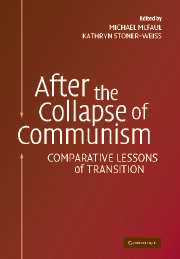Book contents
- Frontmatter
- Contents
- Contributors
- Introduction: The Evolving Social Science of Postcommunism
- 1 The Triumph of Nation-States: Lessons from the Collapse of the Soviet Union, Yugoslavia, and Czechoslovakia
- 2 The Fourth Wave of Democracy and Dictatorship: Noncooperative Transitions in the Postcommunist World
- 3 Circumstances versus Policy Choices: Why Has the Economic Performance of the Soviet Successor States Been So Poor?
- 4 Whither the Central State? The Regional Sources of Russia's Stalled Reforms
- 5 Parties, Citizens, and the Prospects for Democratic Consolidation in Russia
- 6 Comparative Democratization: Lessons from Russia and the Postcommunist World
- 7 Russians as Joiners: Realist and Liberal Conceptions of Postcommunist Europe
- Index
3 - Circumstances versus Policy Choices: Why Has the Economic Performance of the Soviet Successor States Been So Poor?
Published online by Cambridge University Press: 07 September 2011
- Frontmatter
- Contents
- Contributors
- Introduction: The Evolving Social Science of Postcommunism
- 1 The Triumph of Nation-States: Lessons from the Collapse of the Soviet Union, Yugoslavia, and Czechoslovakia
- 2 The Fourth Wave of Democracy and Dictatorship: Noncooperative Transitions in the Postcommunist World
- 3 Circumstances versus Policy Choices: Why Has the Economic Performance of the Soviet Successor States Been So Poor?
- 4 Whither the Central State? The Regional Sources of Russia's Stalled Reforms
- 5 Parties, Citizens, and the Prospects for Democratic Consolidation in Russia
- 6 Comparative Democratization: Lessons from Russia and the Postcommunist World
- 7 Russians as Joiners: Realist and Liberal Conceptions of Postcommunist Europe
- Index
Summary
INTRODUCTION
After the Soviet Union collapsed in December 1991 and market reforms were initiated, the economic performance of the successor states was more than disappointing. By the end of the 1990s, output (GDP) fell by about 50 percent compared to the highest prerecession level of 1989 (see Fig. 1). Investment dropped even more, income inequalities rose greatly so that real incomes declined dramatically for the majority of the population, and death rates increased by about 50 percent with a concurrent decline in life expectancy. In Russia output fell by 45 percent in 1989–98; suicide rates, crime rates, and murder rates skyrocketed; and death rates increased from 1 percent in the 1980s to 1.5 percent in 1994 and remained at this higher level thereafter, which was equivalent to over 700,000 additional deaths annually (see Fig. 2). Over a period of several years, such population losses are comparable to the impact of World War II on Soviet society.
By way of comparison, during the Second World War national income in the USSR fell by only 20 percent in 1940–2, recovered to its 1940 level in 1944, fell again by 20 percent in 1944–6 during the conversion of the defense industry, but exceeded its 1940 level by nearly 20 percent by 1948. In some of the former Soviet states that were affected by military conflicts (Armenia, Azerbaijan, Georgia, Moldova, Russia, and Tajikistan), GDP in 2000 was only 30 to 50 percent of its pretransition levels; in Ukraine, even without the military conflict GDP fell by nearly two-thirds (see Fig. 1).
- Type
- Chapter
- Information
- After the Collapse of CommunismComparative Lessons of Transition, pp. 96 - 129Publisher: Cambridge University PressPrint publication year: 2004
- 1
- Cited by



